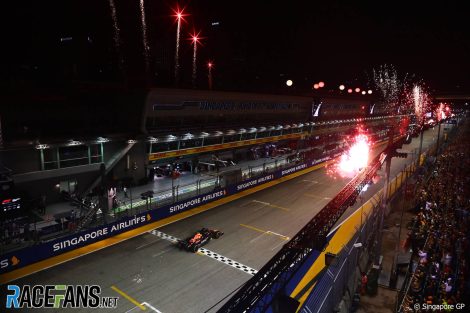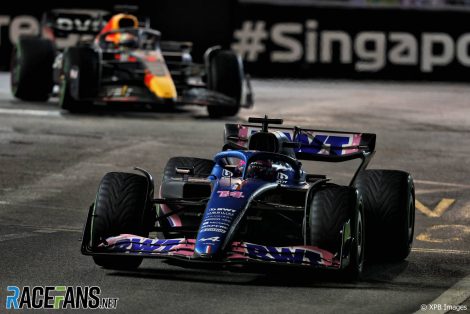Qualifying for the Singapore Grand Prix produced the closest fight for pole position involving three different teams for almost two decades.
When Max Verstappen backed off his final flying lap because his Red Bull team had realised he was going to run too low on fuel, it secured Charles Leclerc’s ninth pole position of the season – and ensured no one will end the year with more of them than the Ferrari driver.Leclerc beat Red Bull’s Sergio Perez by 0.022 seconds and Mercedes’ Lewis Hamilton by 0.054s. That’s the smallest gap which has covered three different teams at the front of a grid for nearly 20 years.
You have to go back to the 2003 Brazilian Grand Prix to find a closer top three involving a trio of different teams. Rubens Barrichello – also in a Ferrari – took pole position for that race by 0.011 seconds from David Coulthard (McLaren) and 0.044s from Mark Webber (Jaguar, which became Red Bull two years later).

However Leclerc lost the lead to Perez at the start – exactly as happened when the pair lined up in the same order in Azerbaijan. Leclerc also repeated his result from the last Singapore GP, by taking pole position and finishing second.
Perez therefore claimed the fourth win of his Formula 1 career, putting him level with Dan Gurney, Bruce McLaren and Eddie Irvine. Following his Monaco Grand Prix win earlier this year, Perez has now scored more than one win in a single season for the first time. Coincidentally, both were street races in which he faced a post-race investigation.
Advert | Become a RaceFans supporter and
This was also the first time in Perez’s career he’s led every lap of a race. It meant his team mate Max Verstappen led no laps, which hasn’t happened since Perez’s Monaco win. Verstappen’s run of nine consecutive races led is the longest of his career to date. His run of five wins in a row, another personal best, also came to an end.

For the first time this year the driver who set the fastest lap did not collect the bonus point as they did not finish inside the top 10. That was George Russell, who took the second fastest lap of his career, the other having come on his first appearance for Mercedes as a substitute for Lewis Hamilton at the Sakhir Grand Prix in 2020.
Behind Perez, Ferrari got both cars on the podium for the first time since the Miami Grand Prix. The McLaren pair were next, taking 22 points, which is the most the team has scored in a single race this year. They scored the same amount at the Emilia-Romagna Grand Prix, but seven of those points came from the sprint race.
Daniel Ricciardo scored his best result of the season so far with fifth place, an impressive gain of 11 positions from where he started. That helped McLaren pass Alpine for fourth in the championship.
Prior to Singapore, all five of Lance Stroll’s points had come from 10th place finishes. He therefore more than doubled his haul with sixth place, equalling the team’s best result of the season which Sebastian Vettel scored in Azerbaijan.
Advert | Become a RaceFans supporter and
Future Aston Martin driver Fernando Alonso made a record-breaking 350th start in the world championship, but had a dissapointing end to it as he was among the six retirees from the race.

However Zhou Guanyu may reconsider inviting his family to races in future. They came to watch as they did at Silverstone, only to see him taken out of the race by another driver again. At least he wasn’t flipped onto his roll hoop this time.
Have you spotted any other interesting stats and facts from the Singapore Grand Prix? Share them in the comments.
Become a RaceFans Supporter
RaceFans is run thanks in part to the generous support of its readers. By contributing £1 per month or £12 per year (or the same in whichever currency you use) you can help cover the costs of creating, hosting and developing RaceFans today and in the future.
Become a RaceFans Supporter today and browse the site ad-free. Sign up or find out more via the links below:
2022 Singapore Grand Prix
- How many victory chances did Hamilton have in his first winless F1 season?
- Alfa Romeo expect another step from Zhou after confirming 2023 deal
- Closest three-team pole fight for almost 20 years in Singapore
- F1 teams back race control’s decisions on delayed start and DRS activation
- It’s “game over” if F1 fails first “vital test” of budget cap rules – Ferrari





Jonathan Parkin
4th October 2022, 18:35
Also to note the first Singapore GP’s to be stopped early were under the previous 2 hour rule. 2017 and 2022 were 2 hours + 1 lap.
hunocsi (@hunocsi)
4th October 2022, 19:49
When did they change that rule? I was very surprised when the commentators said there will be +1 lap.
Jonathan Parkin
4th October 2022, 20:02
Between the 2014 and 2017 races. I don’t know exactly when (or even why) they changed it
hunocsi (@hunocsi)
4th October 2022, 21:26
I think the why is to avoid confusion by possibly prematurely waving or not waving the flag in tight situations, when the lead driver crosses the start finish line and it’s plus/minus a few seconds to 2:00:00, which is why most series have the +1 lap, but I remember F1 was strictly two hours.
Euro Brun (@eurobrun)
4th October 2022, 21:42
+1 lap makes a lot of sense. A couple of years ago a BTCC race at Silverstone ended with the clock hitting zero about half a second before the lead driver crossed the line, meaning the race technically ended (won by less than a second too!), but they couldn’t wave the checker as what if he’d been half a second quicker. So the entire field raced another lap, completely unaware that the race had ended. Probably the best ever racing lap that never was too!
bernasaurus (@bernasaurus)
5th October 2022, 21:27
The +1 lap rule does make sense – if you consider the consequences of a group of cars all approaching the finish line on 1.59.57 and nobody knowing if it’s the end of the race or the start of the last lap.
With radio messages, everyone can keep going until they get a radio message telling them ‘last lap’.
Jere (@jerejj)
5th October 2022, 11:00
@Jonathan Parkin @hunocsi The +1 lap thing has been in place for a long time.
hunocsi (@hunocsi)
5th October 2022, 11:32
@jerejj I found it in the meantime, it was introduced for 2015. Weird that I don’t remember it, since that was the period when I followed the sport and the rules the most closely, but that’s my own problem.
Τάσος
4th October 2022, 18:40
Perez became the first North American driver to win an F1 race at Asia region.
jfflink
4th October 2022, 21:29
Mario Andretti 1976 in Japan!
jff
4th October 2022, 21:31
Mario Andretti 1976 in Japan!
hunocsi (@hunocsi)
5th October 2022, 0:04
When he won in Bahrain in 2020?
Jere (@jerejj)
5th October 2022, 11:01
@hunocsi Yes, as Bahrain is geographically & thus technically in Asia.
F1 frog (@f1frog)
4th October 2022, 19:01
If Juan Manuel Fangio had wanted to beat Fernando Alonso’s record of 350 race starts, he would have to have still been racing in 1981, at the age of 70.
jff
4th October 2022, 21:18
now that’s an interesting stat.
I hope the window for tomorrow’s CotD is still open ;)
Euro Brun (@eurobrun)
4th October 2022, 21:43
Amazing. And maybe Alonso can see himself still competing at 70!
Keith Collantine (@keithcollantine)
4th October 2022, 22:24
@f1frog That’s a great stat, nice one.
frood19 (@frood19)
5th October 2022, 19:12
He was pretty old when he started (well, when F1 started) but a three decades career is striking. Alonso has been around for a lot of years too but I doubt he’ll still be going in 2032!
bernasaurus (@bernasaurus)
5th October 2022, 21:31
Bloody hell @f1frog you’ve out done yourself there!! That’s a great one. To be fair age never seem to deter Fangio – I somewhat disappointed in him that he didn’t achieve it.
paulgilb (@paulgilb)
4th October 2022, 23:05
First time Stroll has made it into Q2 at Singapore.
Having never previously gone out in Q1, Bottas has now fallen at that stage in 3 out of the past 4 races.
First time Hamilton has started in the top 3 in 2022.
800th GP that Williams have started – 3rd constructor after Ferrari and McLaren to reach this figure.
Russell keeps alive his record of either finishing in the top 5 or not scoring in 2022. His two no-scores have both come in races where Verstappen ended a run of victories by finishing 7th.
3rd time in the last 6 races that Tsunoda has started in the top 10 but not finished.
Second time (after Vettel in 2011) that the same driver has won both Monaco and Singapore in one season.
First Singapore winner to start from an even-numbered grid slot.
Thanks to statsf1 and the official F1 site for some of these.
Esploratore (@esploratore1)
5th October 2022, 1:05
Wow, I like the russell-verstappen one!
Pedro (@)
5th October 2022, 16:14
And last year, Perez won Baku as well, so he knows how to win street races in Formula One
Sumedh
5th October 2022, 4:49
The 2003 Brazilian gp qualifying gap of 0.044s is on a base of a 73.807s pole lap. But this Singapore gp gap is on a base of 109.412s pole lap.
So in % terms, this was even closer than the 2003 Brazilian gp qualifying.
Hans Herrmann (@twentyseven)
5th October 2022, 11:01
Good point @sumedhvidwans So that’s .06% in Brazil 2003 Vs. .05% in Singapore this year.
It is amazing that they all lapped so close in three different cars in those conditions.
Of course per the article above Max was on course to smash that pole time.
Qeki (@qeki)
5th October 2022, 10:23
As Alonso got his 351st or 350th start to his name. This was Pirelli’s 434th. They are 59 races behind Goodyear. They will overtake them about in 10th race in 2025.
Goodyear 493 (Japan 1998)
Pirelli 434 (ongoing)
Bridgestone 244 (Abu Dhabi 2010)
Michelin 215 (Brazil 2006)
Dunlop 175 (Japan 1977)
Firestone 122 (Argentina 1975)
Englebert 66 (Morocco 1958)
Avon 29 (Swizerland 1982)
Continental 14 (Usa 1959)
Jere (@jerejj)
5th October 2022, 11:03
K-Mag’s first Q3 appearance in Singapore since 2014.
As a result of Max’s winning streak ending, Seb’s shared streak record is safe for now.
The first time both ATs qualified in the top ten since Baku.
The fifth Singapore GP in which the winner’s overall time exceeded the 2-hour limit & the second-longest to date after the 2017 race that lasted 2:03:23.544 (58 laps). The other such races are from 2012 (2:00:26.144, 59 laps), 2014 (2:00:04.795, 60 laps), & 2015 (2:01:22.118, 61 laps). Reducing race distance to 260 full km like in Monaco (meaning 52 laps for Marina Bay’s lap length) has been for a while.
The third consecutive Singapore GP with the fastest lap going to a driver who finished outside the top ten – furthermore, the sixth after 2019 Singapore, same season Brazilian, & last season’s Azerbaijan, British, & Mexico City GPs.
The latest local start time ever for any race, which will remain until next season’s LV GP return.
Only one of Perez’s four wins has come on a permanent circuit.
Russell’s first FLAP. He also became the 7th different driver to achieve the FLAP accolade this season.
Possibly the first time that the lowest six positions in sector times went for the same six drivers in the same order.
Williams’ first double-DNF since the Saudi-Arabian GP & Alpine’s first since last season’s US GP.